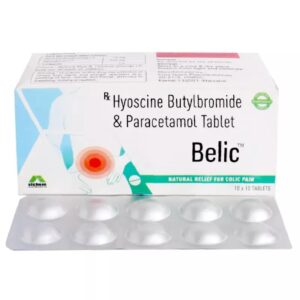PARACETAMOL (ACETAMENOPHEN) + HYOSCINE BUTYL BROMIDE
Paracetamol (acetamenophen): Paracetamol, also known as acetaminophen, is a commonly used over-the-counter (OTC) medication for the relief of pain and fever. It belongs to the class of drugs known as analgesics (pain relievers) and antipyretics (fever reducers).
Paracetamol works by inhibiting the production of certain chemicals in the body, called prostaglandins, which are responsible for transmitting pain and fever signals. It primarily acts on the central nervous system, particularly the hypothalamus, to lower body temperature and reduce pain.
Paracetamol is most commonly used to relieve mild to moderate pain, such as headaches, toothaches, and muscle aches, as well as to reduce fever associated with various conditions, such as colds, flu, and infections.
The recommended dose of paracetamol for adults is typically 500 to 1000 mg, to be taken every 4 to 6 hours, as needed. However, the maximum daily dose should not exceed 4,000 mg to avoid the risk of liver damage. It is important to carefully read and follow the instructions on the packaging or consult a healthcare professional for accurate dosing information.
While generally considered safe when used as directed, paracetamol can have side effects, although they are rare. Common side effects may include nausea, upset stomach, or rash. In certain cases, allergic reactions can occur, such as difficulty breathing, swelling of the face or throat, or hives, and immediate medical attention should be sought if symptoms occur.
It is worth noting that excessive and prolonged use of paracetamol can cause liver damage, particularly when taken in higher doses or alongside alcohol. Therefore, it is essential to adhere to the recommended dose and duration of use.
Paracetamol is widely available without a prescription and is often considered a relatively safe and effective option for pain relief and fever reduction. However, it is always advisable to consult a healthcare professional if the pain or fever persists or worsens, or if there are any concerns or questions regarding its use.
Hyoscine Butyl Bromide: Hyoscine Butyl Bromide, also known as Scopolamine Butyl Bromide, is a medication used to relieve abdominal cramping and spasms caused by conditions such as irritable bowel syndrome, diverticulitis, and urinary tract infections. It belongs to a class of drugs called anticholinergics.
The mechanism of action of Hyoscine Butyl Bromide involves blocking the effects of acetylcholine, a neurotransmitter that plays a role in smooth muscle contraction. By inhibiting the action of acetylcholine, this drug helps relax the smooth muscles in the gut and bladder, relieving symptoms of cramping and spasms.
The recommended dose of Hyoscine Butyl Bromide is usually 10 to 20 mg, taken orally, up to four times a day. However, the specific dosage may vary depending on the individual’s condition and response to the medication. It is important to follow the instructions of a healthcare professional.
Common side effects of Hyoscine Butyl Bromide may include dry mouth, blurred vision, drowsiness, dizziness, and constipation. These side effects are usually mild and temporary. However, if severe or persistent, it is important to seek medical advice.
It is worth noting that Hyoscine Butyl Bromide should be used with caution in individuals with certain medical conditions such as glaucoma, bladder or bowel obstruction, myasthenia gravis, or prostate enlargement. It should also be used cautiously in individuals taking other medications that may interact with it.
As with any medication, it is always advisable to consult with a healthcare professional or pharmacist before starting or changing any treatment plan involving Hyoscine Butyl Bromide to ensure it is appropriate for the individual’s specific needs and medical history.

